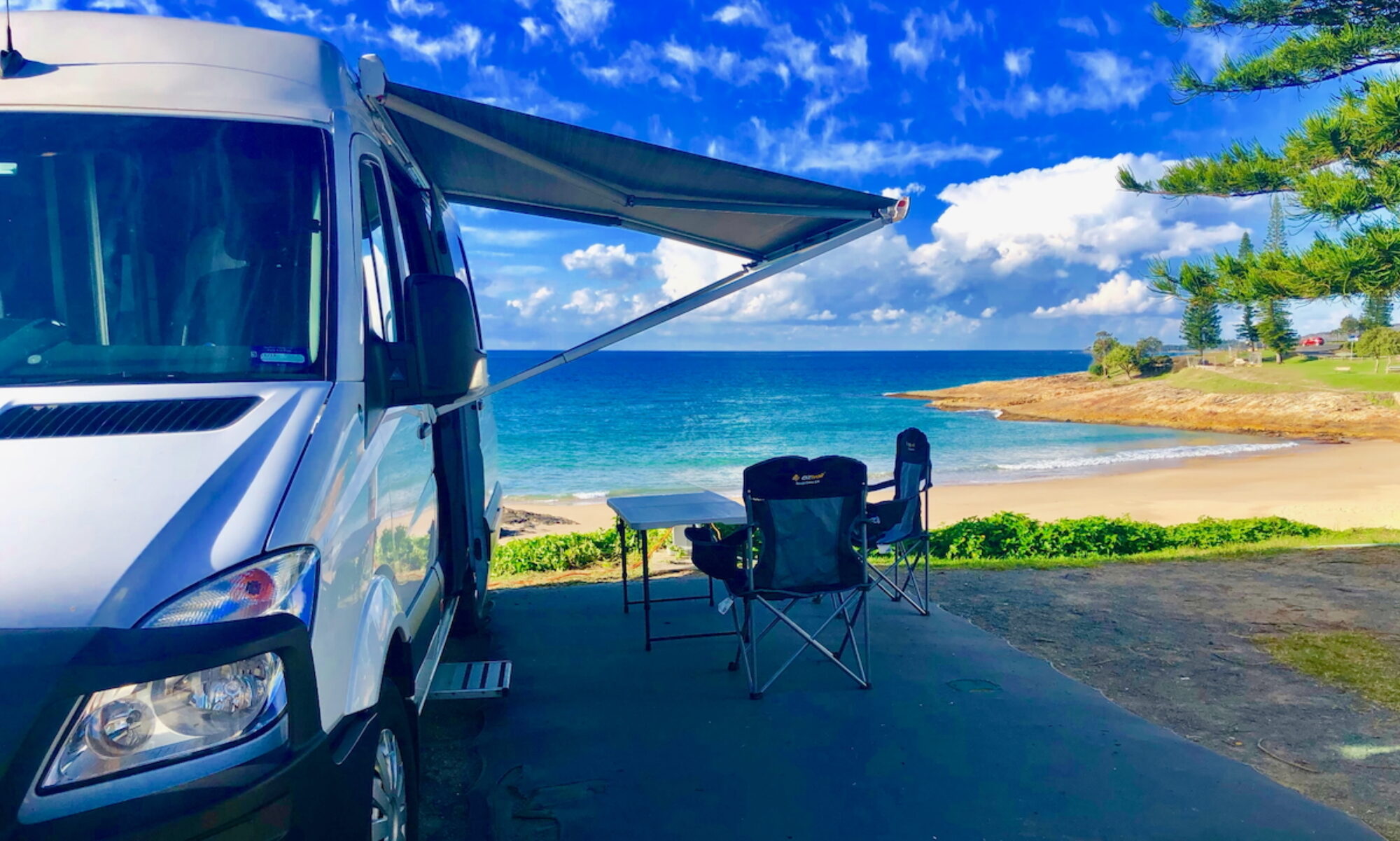See also: Battery Recharging | Solar Charging | Fridge & 12V on the Go
Let’s cut to the chase and bypass the theory and ‘maybe’ stuff. Here is our hands-on, measured experience with solar charging of the batteries in our campervan….
Our setup
-
- Permanent Solar: 150W panel on the roof (Redarc);
- Portable Solar: 200W folding blanket (Kings);
- Battery charger: BCDC 1240D (Redarc);
- Batteries: 2 x 120 Ah Lithium (Sphere);
- Fridge: 110L fridge / freezer (Dometic)

Energy Consumption
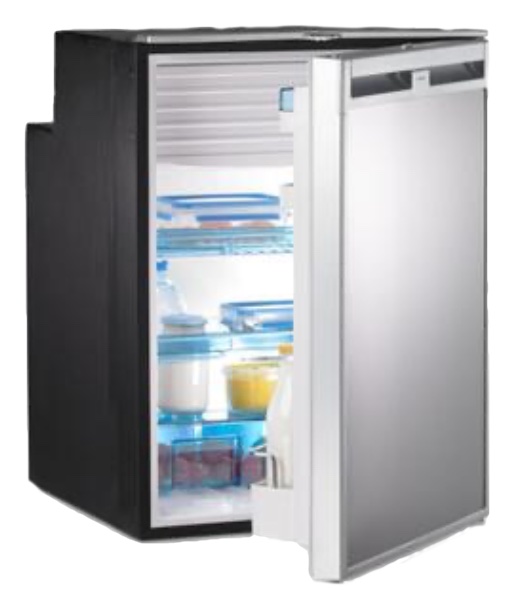 Our fridge is the largest constant 24hr consumer of our batteries’ stored electrical energy. The upright fridge draws just over 3 amps when the compressor is running – consuming around 2.5 Ah of stored battery energy each hour.
Our fridge is the largest constant 24hr consumer of our batteries’ stored electrical energy. The upright fridge draws just over 3 amps when the compressor is running – consuming around 2.5 Ah of stored battery energy each hour.
This adds up to 30 Ah depleted battery storage capacity overnight (6pm – 6am), and another 30Ah during the day (6am to 6pm).
For all the measurement and monitoring listed on this page we have used the fridge as the ‘standard’ device consuming electrical energy from the battery.
Note: For those with a need for long-term off-grid refrigeration, a 3-way absorption fridge is another option, running on LPG rather than electricity. However, a combination of Lithium batteries and quality solar panels may be all you need for indefinite renewable 12V power for refrigeration – if you have enough batteries and panels, and the sun is shining.
Recharging Options
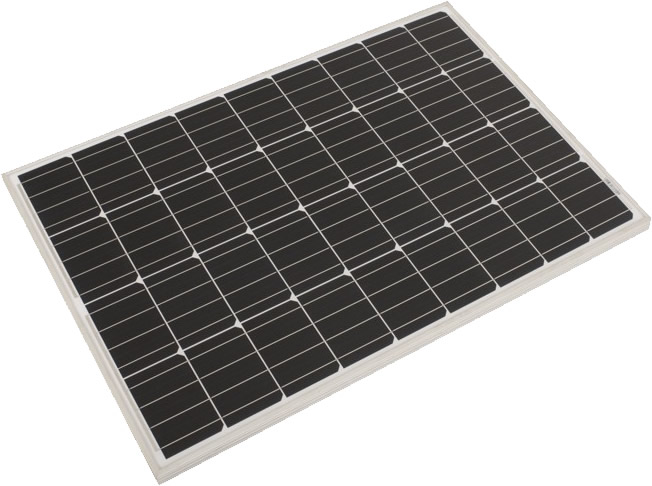 We have a single 150W solar panel mounted on the roof of our van. In the middle of the day (in summer) the panel produces 7.5 amps of electrical energy, theoretically returning 7.5 Ah of stored energy to the batteries per hour.
We have a single 150W solar panel mounted on the roof of our van. In the middle of the day (in summer) the panel produces 7.5 amps of electrical energy, theoretically returning 7.5 Ah of stored energy to the batteries per hour.
On a sunny summer day the 150W solar panel restores around 52 Ah of electrical energy over a 12 hour period (6am – 6pm).
Our other charging sources include the vehicle alternator, a 230V mains charger, and a portable 200W solar blanket.
The 200W solar blanket is a ‘cheapie’ from Kings, and generates a maximum 6 amps in the middle the day. (Less than the 150W Redarc rooftop panel!) This panel returns around 6 Ah per hour to the batteries, while the sun is shining.
The Energy Balancing Act
Our fridge consumes 2.5 Ah of stored energy per hour, every hour of the day. whether the sun is shining or not. The 24 hour energy consumption of the fridge is 60 Ah. (Probably a bit more in hot weather but we will work with the 60 Ah as a nice round figure.)
In the middle of the day the 150W solar panel is generating 7.5 Ah per hour – less in the morning and afternoon. Our monitoring indicates that between 6am and 6pm (in summer) the solar panel returns around 52 Ah of electrical energy to the batteries.

That’s a 24 hour net deficit of around 8 Ah of stored electrical energy.
Longevity
Our 240 Ah Lithium batteries have a usable capacity of 192 Ah (80% of label capacity). (Some Lithium battery suppliers claim 100% usable capacity – though we prefer to play it safe with 80%).
So, with a daily energy deficit of 10 Ah (8 Ah for the fridge, plus another 2 Ah for the water pump, TV, lights, etc) we can free-camp for 2 ½ weeks (18-19 days) if the sky is clear and the sun is shining.
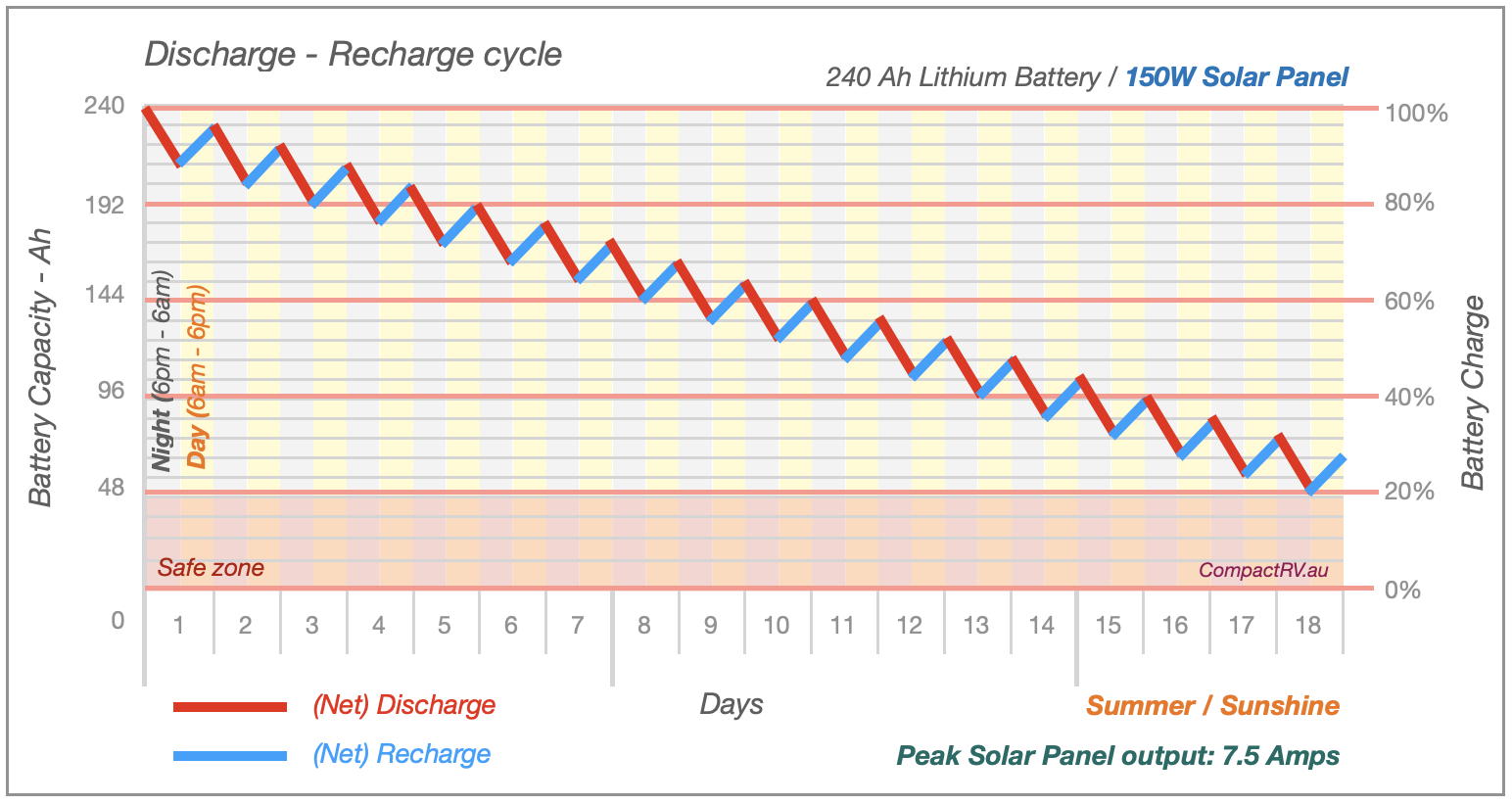
Charging alternatives
As noted above, our supplementary 200W portable solar blanket produces around 6 amps when connected to the DC-DC battery charger (via an Anderson plug fitted beneath the vehicle). Between 6am and 6pm this blanket returns around 40 Ah of electrical energy to the batteries. (Expert advice suggests that with two solar panels connected to the Redarc charger, the input from the larger panel is restricted to the input from the smaller panel. Which isn’t a problem for us, since the ‘larger’ panel is a cheapie with a lower output anyway.)
In tandem with the 52 Ah generated by the 150W rooftop panel, this will more than negate the 10 Ah daily deficit (when using only the rooftop panel), extending our free-camping capacity indefinitely – when the sun is shining.
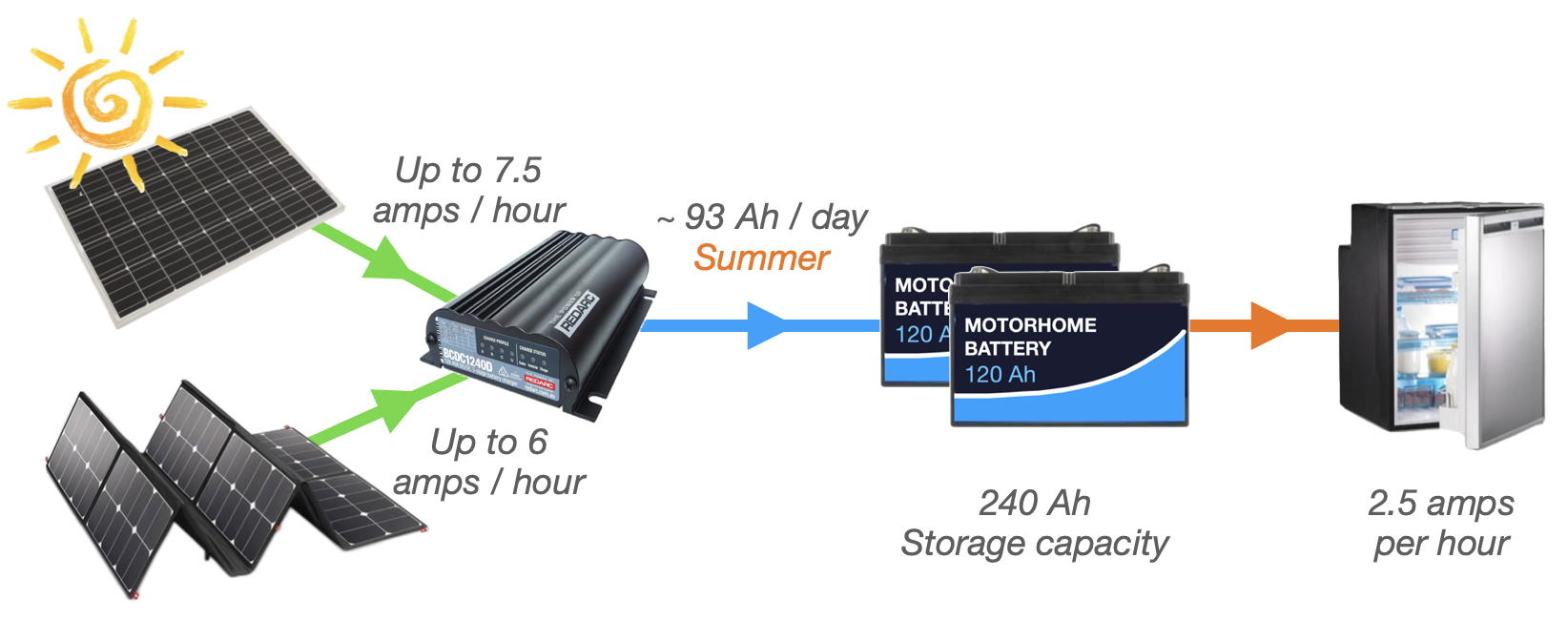
Once we have more electrical energy being generated by the solar panels than we have energy being consumed by the fridge (and other devices), our possible off-grid time becomes indefinite – assuming clear sunny skies…..
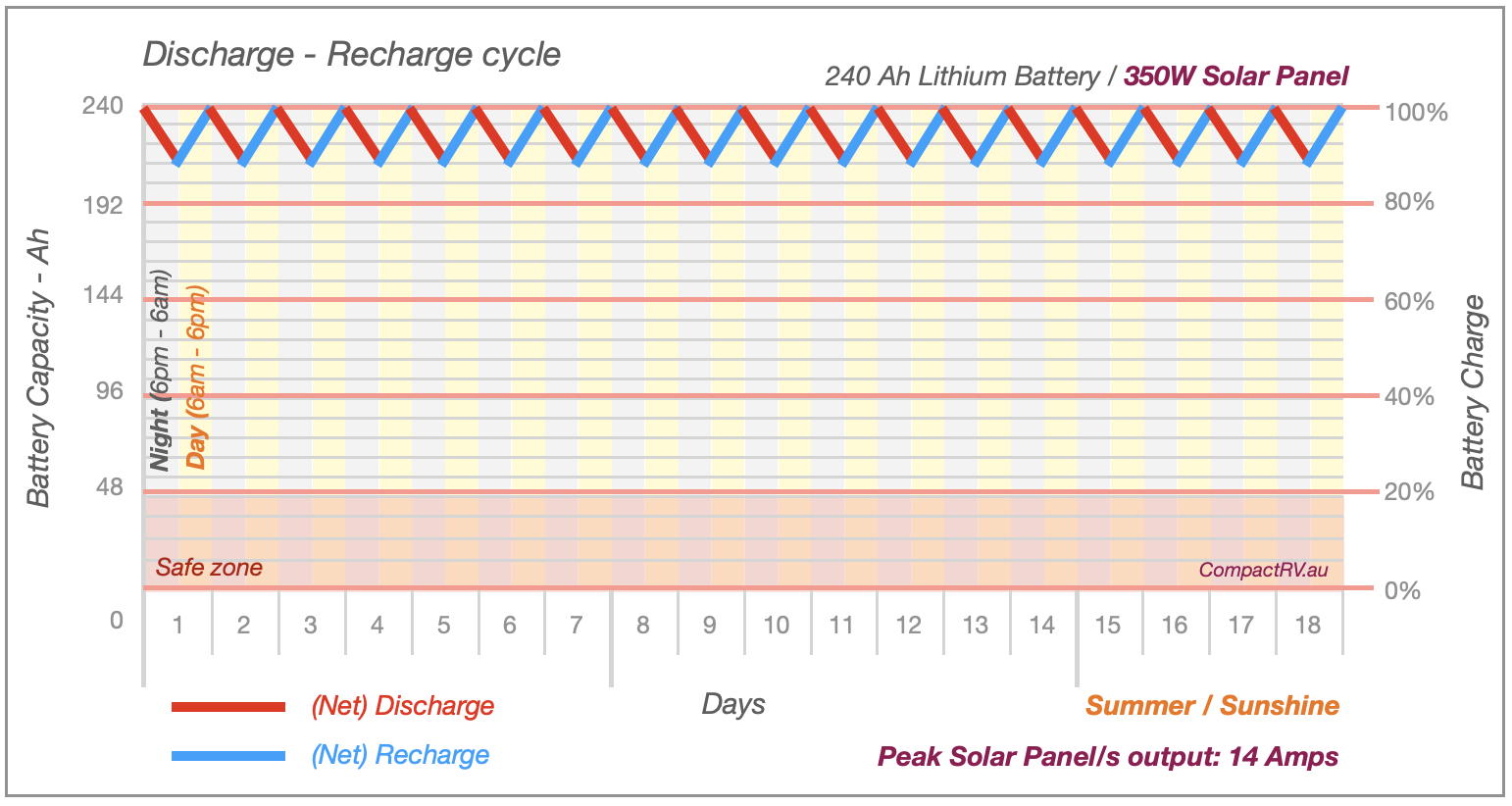
With cloudy skies, and minimal charging from the solar panel/s, battery capacity becomes a more critical factor.
Of course, we also have DC charging available from the alternator, and 230V AC charging available when connected to a mains supply.
Seasonal fluctuations
 These figures are for comparison using only the 110L fridge as a discharging appliance (2.5 Ah per hour) and the 150W solar panel as a charging source:
These figures are for comparison using only the 110L fridge as a discharging appliance (2.5 Ah per hour) and the 150W solar panel as a charging source:
-
- Summer: Daily deficit = 8 Ah
- Autumn: Daily deficit = 14 Ah
- Winter: Daily deficit = 16 Ah (est)
- Spring: Daily deficit = 14 Ah (est)
The Nitty Gritty
 What gear do you need to keep the fridge cold when camping off the grid (in sunny weather)?
What gear do you need to keep the fridge cold when camping off the grid (in sunny weather)?
-
- Weekends: a 120Ah Lithium battery and (maybe) a portable solar panel or blanket;
- Short term (less than a week): a 120 Ah Lithium battery and a good quality 150W – 200W solar panel;
- Extended trip (a couple of weeks): 240 Ah of Lithium battery capacity, and 400W of solar panel capacity;
- Longer term (more than 3 weeks): 400 Ah of Lithium battery capacity and 600W of solar panel capacity.
All the above examples assume sunny skies to generate electrical energy from a solar panel. Be prepared with additional battery capacity or alternate charging options if the sun isn’t shining!
Keep in mind too that the other important consumable for off-grid camping is water. You will likely exhaust your water supply before your electricity supply.
See also: Battery Recharging | Solar Charging | Fridge & 12V on the Go
